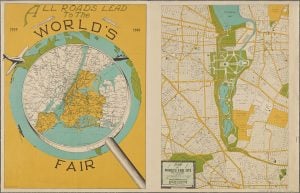1939: Financial Failure
At the fair’s close, the New York World’s Fair Corporation and its many stakeholders realized that the financial reality was not as bright as they had hoped.

Map of the expansive fair grounds, 1939. Via the New York Public Library.
After the 1939 season, the fair had drawn only twenty-six million people, falling far short of expectations. With financial failure looming, the management advertised amusement exhibits over educational ones and replaced Grover Whalen with banker Harvey Gibson. Still, visitors failed to materialize.
Expenses constituted part of the problem. The fair cost 75 cents per adult to enter and 50 cents to park, or roughly five times what it cost to see a movie in 1939. This proved to be substantial sum when the average family only earned about 1,500 dollars and enjoyed only 15 disposable income dollars per year.
Further, the fair’s promotion of labor-saving machinery may have inadvertently worked against it by increasing anxiety of millions of unemployed laborers. For whatever reason, as its second season drew to a close the corporation filed for bankruptcy and the fair closed in financial ruin.